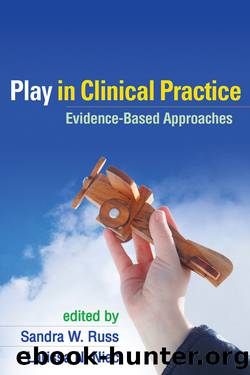Play in Clinical Practice by Russ Sandra W.;Niec Larissa N.;

Author:Russ, Sandra W.;Niec, Larissa N.; [W. RUSS LARISS A N. NIEC, SANDRA]
Language: eng
Format: epub
ISBN: 655566
Publisher: Guilford Publications
In TF-CBT, relaxation skills are taught to children to not only help them manage general feelings of stress, but also to help anxious and/or avoidant children cope with the anxiety and/or avoidance triggered by the therapy process itself. Relaxation skills help youngsters to feel a greater sense of control over the anxiety and fear they may experience when confronted with abuse reminders in the context of therapy (Deblinger & Heflin, 1996). When relaxation skills are introduced, they are geared to the childâs developmental stage and are often playful in nature. Youth, particularly teenagers, may be taught progressive relaxation including guided tension-releasing exercises. The recommendation of Koeppen (1974) to include fantasy in relaxation to maintain the attention and interest of younger children is integrated into the majority of current examples of relaxation exercises with children. For example, Barbara Bonner and colleagues created a script called âThe Land of Dinosaursâ which guides children back to âthe time of the dinosaurs,â imagining they are âhugeâ dinosaurs with âlong necksâ to stretch up to the tall trees to eat the leaves. The âdinosaursâ are guided to lie down on the ground, feeling the sun shining on them, to stretch out, to take some deep breaths and fill their âgigantic lungsâ up with air, and to slowly release the air. The script continues to guide children through relaxation exercises including stretching, progressive muscle relaxation (e.g., tensing the jaw and then releasing it, lifting the shoulders as close to their ears as they can as they try to get under low hanging trees), and breathing (Bonner et al., 2003).
Simpler imagery may be used with younger children by asking them to pretend that their body is in a state of tension, like a âtin soldierâ or an âuncooked piece of spaghettiâ and then after a count of five to release their bodies into a state of relaxation like a âwet noodleâ (Deblinger & Heflin, 1996). Another way to introduce relaxation to children includes controlled, belly breathing. For example, children are asked to imagine the expansion of their stomach on the inhale âas if it were a balloon being blown up,â and then to imagine on the long exhale that the balloon is flying away as all of the air is being released from it. In another example, presented by Runyon et al. (1998), an expansion was made on a muscle relaxation sequence originated by Morris and Kratochwill (1983) to include fantasy: children are instructed to pretend they are blowfish, âtake a deep breath and hold it for 10 seconds, hold it in like a big round blowfish, and let it out watching the air bubbles float up through the water. Raise both of your hands about halfway above the couch and pretend that you are reaching for a colorful rainbow, breath normally, then drop your hands and relax.â Another example of a playful way to introduce controlled, belly breathing includes the use of bubbles. Children are provided a container of bubbles and are encouraged to practice slow, controlled breathing with deep inhales and long, deliberate exhales as they blow bubbles.
Download
This site does not store any files on its server. We only index and link to content provided by other sites. Please contact the content providers to delete copyright contents if any and email us, we'll remove relevant links or contents immediately.
Chicken Soup for the Soul Presents Teens Talkin' Faith by Jack Canfield(635)
Understanding PDA Autism in Kids: A Guide for Parents and Teachers to Support Neurodiverse Learners by Jehu Len(553)
The Victorian Era: A Captivating Guide to the Life of Queen Victoria and an Era in the History of the United Kingdom Known for Its Hierarchy-Based Social Order by Captivating History(422)
Brain Teasers to Build Critical Thinking Skills by Safarova Kris(411)
Brain Teasers to Build Critical Thinking Skills: Brain Exercises for Tech, Banking, Case Interview Prep, and to Keep Your Mind Sharp by Kris Safarova(411)
100 Ideas for Secondary Teachers: Engaging Parents by Janet Goodall & Kathryn Weston(386)
Python 101 - Fundamentals by Sam(373)
Critical Curriculum Leadership : A Framework for Progressive Education by Rose M. Ylimaki(360)
Writing Solid Code: Development Philosophies for Writing Bug-Free Programs by Steve Maguire(355)
The Art of Emotional Validation: Improve Your Communication Skills and Transform Your Relationships by Validating Emotions and Feelings by Emily Wright(338)
Intersectionality in Educational Research by Dannielle Joy Davis; James L. Olive; Rachelle J. Brunn-Bevel; Susan R. Jones(331)
The Knights Templar: An Enthralling History of the Rise and Fall of the Most Influential Catholic Military Order by Wellman Billy(327)
A Beginner's Guide to SSD Firmware by Unknown(326)
The Future Knowledge Compendium by Ellyard Peter;(319)
How to be assertive in any situation by Hadfield Sue & Hasson Gill(308)
Making Connections in and Through Arts-Based Educational Research by Hala Mreiwed Mindy R. Carter Sara Hashem Candace H. Blake-Amarante(305)
Foundations of Educational Research by Victoria Elliott(305)
What Every Teacher Should Know about Learning, Memory, and the Brain by Tileston Donna E. Walker;(305)
Message from the Pleiades; The Contact Notes of Eduard Billy Meier v1 only by unknow(301)
